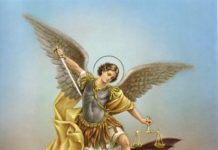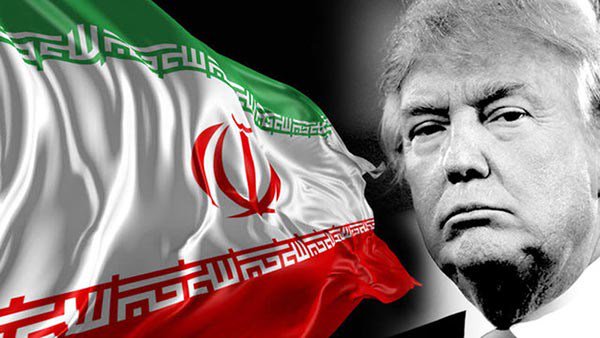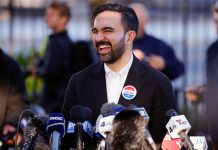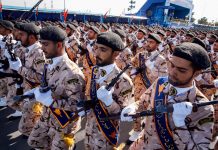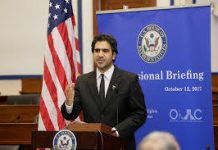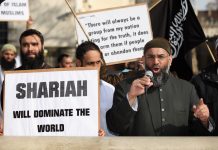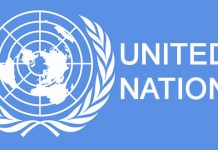Rouhani and Trump: Together against Iran’s Men with Guns?
Amir Taheri/Asharq Al Awsat/July 07/17
These days something strange is happening with regard to Iran. You might say: so what? Strange things have been happening with regard to Iran ever since the mullahs seized power in 1979.
Alright, but what is happening now may merit closer attention because it represents an unprecedented convergence between the thinking of the Trump administration in Washington, on the one hand, and that of one of the factions involved in the power struggle in Tehran, on the other. Last month, US Secretary of State Rex Tillerson announced that the Trump administration is putting final touches to a new policy on Iran with the ultimate aim of regime change. While details of this new policy remain a mystery, one thing maybe clear: one of its aims would be the dismantling of the Islamic Revolutionary Guard Corps (IRGC), which US experts identify as the mainstay of the Khomeinist regime.
National Security Adviser General H.R. McMaster has more than hinted at this, while a number of Republican policymakers, among them Senator Tom Cotton, have evoked the designation of the IRGC as a “terrorist organization.” Parallel to those developments, the Islamic Republic’s own President Hassan Rouhani has launched a campaign of vilification against the IRGC. Some analysts dismiss Rouhani’s attacks as mere posturing.
After all, they argue, Rouhani himself is a product of the military-security complex based on the IRGC. Thus, his attacks on the IRGC, labeling it “a state with guns within the state,” may be a trick to hoodwink the gullible Americans into continuing Barrack Obama’s policy of propping up “the moderate faction” in Tehran.
This may well be the case. However, the IRGC sees Rouhani’s attacks as the domestic angle of a “plot” being hatched in Washington. In an editorial published in the daily Javan, principal organ of the IRGC, General Yadallah Javani, says so with surprising clarity. “What the President is saying (against the IRGC) is exactly copied from what the Western media have been saying for years,” he writes. Another commander, Hamid-Reza Muqaddam-Far goes even further by accusing Rouhani and his clan of “unsheathing their swords” against the IRGC by “lying across the board”.
The IRGC’s Commander-in-Chief General Aziz Jaafari has linked Rouhani’s statements to efforts by the US to limit or even halt Iran’s project of building long-range missiles. “Yes, we own missiles that smash the enemy,” Jaafari said in a speech a day before “Supreme Guide” Ali Khamenei reappointed him as IRGC commander-in-chief for a further three years. Never missing an opportunity to attract publicity, General Qassem Soleimani, commander of the Quds Corps, has also entered the debate by claiming that “without the IRGC there will be no country!” The so-called “moderate faction” led by the late Hashemi Rafsanjani and former President Mohammed Khatami has always told Western powers, notably the US, that the IRGC is a the principal hurdle on the way to the Islamic Republic’s change of behavior and “normalization.”
This was the theme that Foreign Minister Mohammed Javad Zarif used with some success in numerous appearances in American policy circles and think-tanks. His claim was that Iran’s interventions beyond its borders were due to the IRGC’s ambition to make the Islamic Republic a regional superpower, while “the moderates” wanted nothing but “win-win relations” with the West.
Last week, that theme was taken up by Rouhani in a speech in Tehran. “Our aim should not be to become the strongest power in the region,” he said. “What we want is a stronger region.”However, becoming the regional “first power” is clearly stated as the principal goal of the Islamic Republic’s 20-Year Strategy, approved by the “Supreme Guide” in 2014.
In an editorial last Tuesday, the daily Kayhan, reflecting Khamenei’s views, insisted that becoming “the regional superpower” was not a matter of choice, but one of necessity for the Islamic Republic. The principal means of attaining that goal is the IRGC and its growing military power. The current campaign to clip the wings of the IRGC is a reminder of the brief attempt by Khatami to disband the force by merging it with the regular armed forces.
It also echoes the campaign launched in the 1970s by the Shah’s many enemies to break the Iranian armed forces. At the time, the Khomeinists, the pro-Soviet Communists, the People’s Muajahedin, Libya under Moammar Gadhafi, the Palestinians led by Yasser Arafat, leftist parties in Western Europe and certain circles in the US worked together, albeit in an informal way, to vilify the Iranian army and mobilize Iranian and world opinion against it. Days after he seized power in 1979, Khomeini declared the destruction of the army as one of the top aims of his regime. The process of dismantling the army stopped only when Saddam Hussein invaded Iran in September 1980.
Clipping the wings of the IRGC may be in the short-term interest of the “moderate” faction, which has held the presidency for 20 out of the past 38 years but, because of implicit or explicit opposition from the IRGC, failed to impose its full agenda on the Islamic Republic. Thus by helping destroy the IRGC, Trump would be helping he “moderates”, often also known as the “New York Boys.”The question is whether the “New York Boys”, who lack a popular base, would be able to keep Iran together, let alone implement policies that might please Trump or any other US president.
And what if, at some point and under certain conditions, one might need the very same IRGC to push the mullahs back to the mosques and seminaries? To be sure, the IRGC is not the Shah’s army in the sense that it consists of more than a dozen bits and pieces with little esprit de corps and held together by expediency. However, one should not forget that Khomeini’s campaign to destroy the Iranian army amounted to a direct invitation to Saddam to invade Iran and to the USSR to occupy Afghanistan with all the consequences.
The dismantling of the IRGC may help the “moderates” for a while, but it could also open the way for ethnic revolts, civil war and larger scale terrorism in and around Iran. As Trump ponders his Iran policy, he should remember that nothing about Iran is as simple as the “New York Boys” claim. They sold Obama a bill of goods. Trump, the “dealmaker,” shouldn’t buy the same thing.
روحاني وترمب: معاً في مواجهة {الحرس الثوري}؟
أمير طاهري/الشرق الأوسط/07 تموز/17
ثمة أمر غريب يدور هذه الأيام فيما يخص إيران. وربما تقول في نفسك: حسناً، وما الجديد بالأمر؟ تعايش إيران أموراً غريبة منذ استيلاء الملالي على السلطة عام 1979.
حسناً، لكن ما يجري الآن يستحق الاهتمام لأنه يمثل توافقاً غير مسبوق بين تفكير إدارة ترمب في واشنطن من ناحية وأحد الفرق المشاركة في صراع على السلطة داخل طهران من ناحية أخرى.
الشهر الماضي، أعلن وزير الخارجية الأميركي ريكس تيلرسون أن إدارة ترمب تعكف على وضع اللمسات الأخيرة على سياسة جديدة تجاه إيران ترمي لتغيير النظام. ورغم أن تفاصيل السياسة الجديدة لا تزال قيد السرية، فإن أمراً واحداً ربما يكون واضحاً أن أحد أهدافها سيتمثل في تفكيك الحرس الثوري الإسلامي الذي يعتبره خبراء أميركيون الدعامة الأساسية للنظام الخميني.
من جانبه، لمح مستشار الأمن الوطني الجنرال إتش. آر. مكماستر أكثر من مرة إلى هذه الفكرة، بينما دعا عدد من أعضاء الكونغرس عن الحزب الجمهوري، بينهم السيناتور توم كوتون، إلى تصنيف الحرس الثوري باعتباره «منظمة إرهابية».
وبالتزامن مع هذه التطورات، شن رئيس الجمهورية حسن روحاني حملة طعن ضد الحرس الثوري. ويرى بعض المحللين أن هجمات روحاني لا تعدو كونها محاولة لتعزيز صورته. ويشير هؤلاء إلى أن روحاني نفسه يعد نتاجاً للمؤسسة العسكرية – الأمنية. وعليه، فإن هجومه ضد الحرس الثوري ووصفه إياه بـ«دولة تحمل السلاح داخل الدولة» ربما لا يعدو كونه حيلة لدفع الأميركيين نحو المضي في سياسة باراك أوباما القائمة على دعم «الفصيل المعتدل» داخل طهران.
ربما يكون ذلك صحيحاً، لكن الواضح أن الحرس الثوري ذاته ينظر إلى هجمات روحاني باعتبارها العنصر المحلي في خيوط «مؤامرة» تحاك داخل واشنطن. وفي مقال افتتاحي نشرته صحيفة «جوان» اليومية، اللسان الرئيسي للحرس الثوري، تحدث الجنرال يد الله جواني عن هذه الفكرة بوضوح شديد، وقال: «ما يقوله الرئيس (بحق الحرس الثوري) الحديث ذاته الذي تروج له وسائل الإعلام الغربية منذ سنوات».
وذهب قائد آخر، حميد رضا مقدم فر، لأبعد من ذلك باتهامه روحاني وعشيرته بـ«استلال سيوفهم» في وجه الحرس الثوري.
وربط قائد الحرس الثوري الجنرال عزيز جعفري تصريحات روحاني بجهود الولايات المتحدة لتقييد أو حتى وقف المشروع الإيراني لبناء صواريخ طويلة المدى. وقال في خطاب ألقاه قبل يوم من إعادة تعيين «المرشد الأعلى» علي خامنئي له قائداً للحرس الثوري لثلاث سنوات أخرى: «نعم، نملك صواريخ بمقدورها سحق العدو».
واستمراراً لنهجه المعتاد القائم على عدم تفويت أي فرصة لجذب الأنظار، اقتحم الجنرال قاسم سليماني، قائد «فيالق القدس»، الجدال بادعائه أنه «من دون الحرس الثوري لن يكون هناك وطن!».
من ناحية أخرى، دائماً ما أكدت شخصيات مما يطلق عليها «الفصيل الوطني» بقيادة الراحل هاشمي رفسنجاني والرئيس السابق محمد خاتمي أمام القوى الغربية، خصوصا الولايات المتحدة، أن الحرس الثوري يشكل العقبة الرئيسية أمام تغيير سلوك الجمهورية الإسلامية و«تطبيعه».
وكان هذا ما اعتاد وزير الخارجية جواد ظريف ترديده بنجاح خلال عدد من مشاركاته داخل دوائر أميركية ومنظمات فكرية. ودار الادعاء الرئيسي لظريف حول أن تدخلات إيران فيما وراء حدودها تعود إلى طموحات الحرس الثوري في تحويل الجمهورية الإسلامية إلى قوة إقليمية عظمى، بينما لا يرغب «المعتدلون» إلا في بناء «علاقات تعود بالنفع على الجانبين» مع الغرب.
الأسبوع الماضي، تعرض روحاني لهذه الفكرة في خطاب ألقاه داخل طهران. وقال: «ينبغي أن يتمثل هدفنا في ليس التحول إلى أقوى قوة داخل المنطقة، وإنما ما نرغبه هو بناء منطقة قوية».
ومع ذلك، فإن هدف التحول إلى «القوة الأولى» إقليمياً منصوص عليه صراحة في استراتيجية الأعوام الـ20 للجمهورية الإسلامية التي أقرها «المرشد الأعلى» عام 2014.
وشدد مقال افتتاحي نشر الثلاثاء الماضي في صحيفة «كيهان» اليومية، التي تعكس آراء خامنئي، على أن التحول إلى «قوة عظمى إقليمياً» ليس مسألة اختيارية، وإنما ضرورة بالنسبة للجمهورية الإسلامية. وأضاف المقال أن السبيل الرئيسي للوصول إلى هذا الهدف يتمثل في الحرس الثوري وقوته العسكرية المتنامية.
وتذكرنا الحملة الحالية لتشذيب جناح الحرس الثوري بالمحاولة الموجزة التي بذلها خاتمي لحل القوة من خلال دمجها في القوات المسلحة النظامية. أيضاً، تحمل الحملة الحالية أصداء أخرى قادها الكثير من أعداء الشاه في سبعينات القرن الماضي لتحطيم القوات المسلحة الإيرانية. في ذلك الوقت، عمل الخمينيون والشيوعيون الموالون للاتحاد السوفياتي وحركة «مجاهدين خلق» والنظام الليبي بقيادة معمر القذافي والفلسطينيون بقيادة ياسر عرفات وأحزاب يسارية في غرب أوروبا ودوائر معينة داخل الولايات المتحدة، معاً وإن كان على نحو غير رسمي، لتشويه صورة الجيش الإيراني وتعبئة الإيرانيين والرأي العام العالمي ضده.
وبعد أيام من استيلائه على السلطة عام 1979 أعلن خميني تدمير الجيش باعتباره أحد الأهداف الرئيسية لنظامه. ولم تتوقف عملية تفكيك الجيش سوى عندما غزا صدام حسين إيران في سبتمبر (أيلول) 1980.
ومع أن تشذيب أجنحة الحرس الثوري ربما يخدم المصلحة قصيرة الأمد للفصيل «المعتدل» الذي تولى الرئاسة على مدار 20 عاماً من بين إجمالي 38 عاماً، فإن المعارضة الضمنية أو الصريحة من جانب الحرس الثوري جعلت هذا الفصيل عاجزاً عن فرض كامل أجندته على الجمهورية الإسلامية.
وعليه فإنه من خلال معاونته في تدمير الحرس الثوري، سيخدم ترمب بذلك «المعتدلين»، الذين عادة ما تجري إليهم الإشارة باسم «صبية نيويورك» ويفتقرون إلى قاعدة شعبية، بحيث يتمكنون من إبقاء إيران موحدة، ناهيك عن اتباع سياسات قد ترضي ترمب أو أي رئيس أميركي آخر.
ومع هذا، ماذا لو أنه في لحظة ما وفي ظل ظروف معينة احتاج المرء للحرس الثوري لدفع الملالي للعودة إلى المساجد والمدارس الدينية؟
المؤكد أن الحرس الثوري يختلف كثيراً عن جيش الشاه من حيث إنه يتألف من عشرات الفصائل والفرق الصغيرة لا تجمعها روح معنوية واحدة. ومع هذا، لا ينبغي لنا إغفال أن حملة خميني لتدمير الجيش الإيراني بدت بمثابة دعوة لصدام حسين لغزو إيران وللاتحاد السوفياتي لاحتلال أفغانستان بكل ما حملته الخطوتان من تداعيات.
وبذلك، فإن تفكيك الحرس الثوري ربما يخدم «المعتدلين» لبعض الوقت، لكنه في الوقت ذاته ربما يفتح الطريق أمام ثورات عرقية وحرب أهلية وأعمال إرهابية على نطاق أوسع داخل وحول إيران. ومع دراسة ترمب لسياسته الجديدة حيال إيران، فإن عليه أن يتذكر أن إيران في حقيقتها ليست بالبساطة التي يروج لها «صبية نيويورك». لقد باع هذا الفصيل هذه الفكرة لأوباما، لكن من المفترض أن يكون ترمب أذكى من ذلك.







